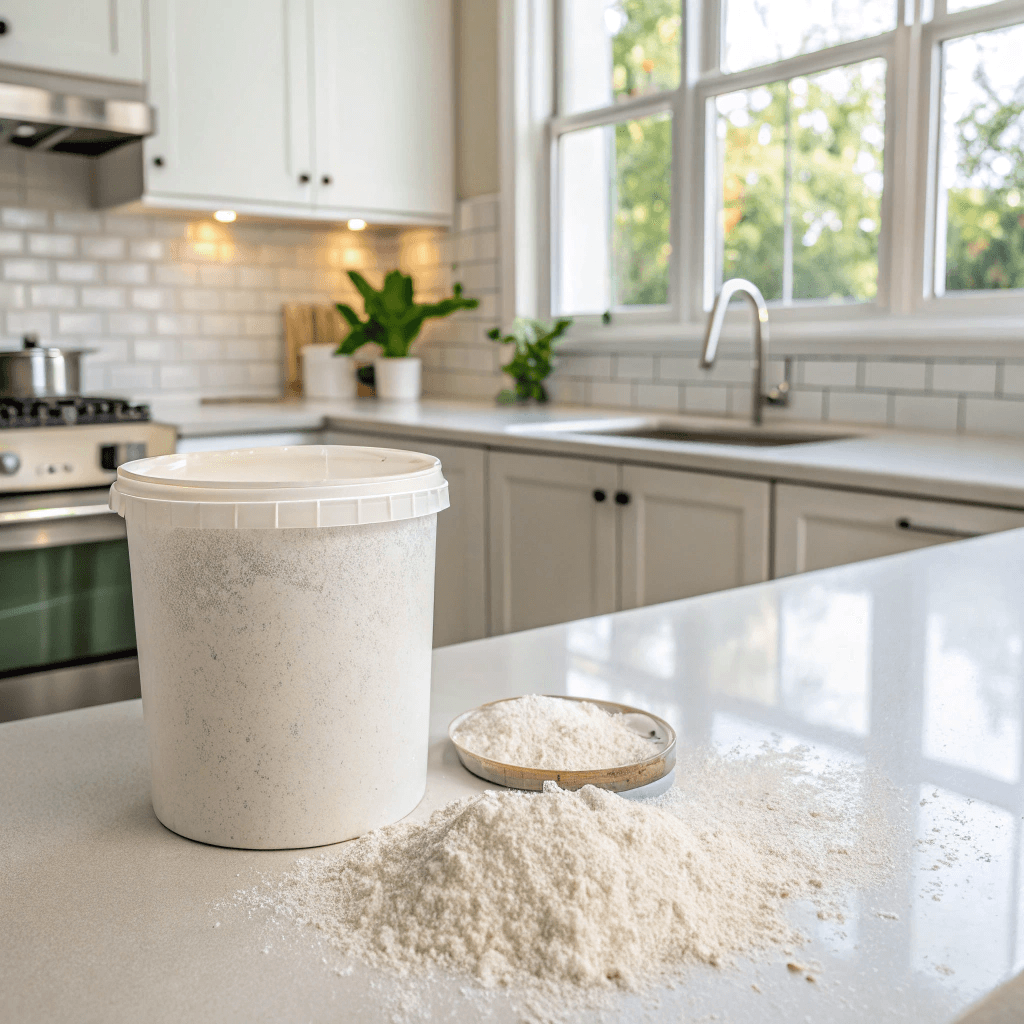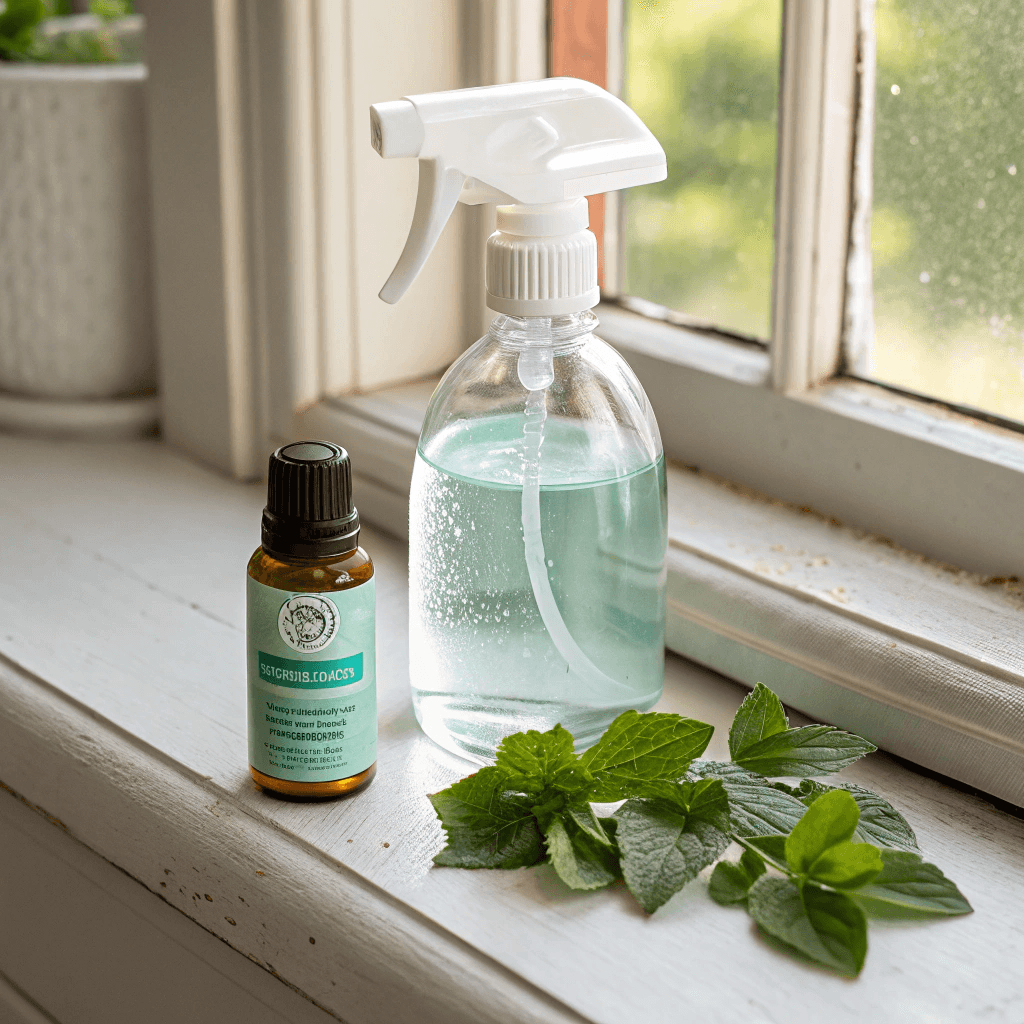How to get rid of sugar ants in kitchen is a question every homeowner dreads but eventually asks. If you’ve ever opened your pantry only to find a trail of tiny ants making their way to a sugar jar or cereal box, you know how frustrating sugar ants in the kitchen can be, especially during the summer months.
Sugar ants are one of the most common complaints, especially in kitchens. No matter how careful I am about where I leave food in the summer, an ant always seems to show up, ready to call in its army for some sweet candy.
These persistent little critters, also known as odorous house ants, aren’t just annoying – they can quickly become an infestation if left unchecked. But before you reach for harsh chemicals or pesticides, there are plenty of natural, safe, and effective ways to eliminate them.
Whether you’re a renter or a homeowner, knowing how to combat these invaders without harming your family or pets is important. Keep in mind that while ants can be annoying, they are still animals, and using harsh chemicals isn’t always the best option.
Table of Contents
What Are Sugar Ants?
Sugar ants are small, black, or brown, and prefer sugary foods (hence the name). Common odorous house ants appear near sweet foods such as candy, drinks, and fruit. They have a strong sense of smell and are attracted to spilled food, crumbs, and containers with an open honey jar. They enter through cracks, holes, or gaps in doors and windows for food and water.
Once they find a food source, they leave a pheromone (known as formic acid) trail that other ants can follow and come, making it hard to get rid of them unless you act quickly. Probably, you have caught one of these ants and noticed their strong, slightly bitter smell, which some describe as smelling like a rotten coconut.

I find it unpleasant, yet I still sniff them every time, and it always makes me feel sick.
Why Sugar Ants in Kitchen?
Before jumping into solutions, it’s important to understand why sugar ants are so drawn to your kitchen because it offers everything they need – plenty of food, moisture, and warmth – essentially making it an all-inclusive resort for them.
How to Get Rid of Sugar Ants in the Kitchen – Naturally Ways
1. Identify the Source of the Problem
The first step in getting rid of sugar ants is locating where they’re coming from. You might see them on your countertops, but the real location could be hidden. At home, they often come from tiny cracks in the windows or hidden corners of the floor.

Follow their trail – look for cracks in walls, door frames, or window seals where they could enter.
Once you’ve identified the entry points, you can block them off or fill them. During one kitchen renovation, we discovered ants entering through the smallest crack behind the refrigerator. A quick fix with caulk solved the problem permanently.
Tip: A magnifying glass can help trace tiny entry points that are easy to miss.
2. Vinegar and Essential Oils to Destroy Ant Trails

Ants leave a pheromone trail to guide other ants to the food source. If you don’t break that trail, they’ll keep coming back. A simple solution of water and white vinegar (1:1 ratio) is highly effective at erasing these trails.
You can add essential oils like peppermint, tea tree, or lemon for extra potency. Not only do these oils help destroy the trail, but they also repel ants because they can’t stand the strong scent.
Tip: Keep a spray bottle filled with mixed water and vinegar and a few drops of essential oil, and wipe down counters and window sills daily to prevent future infestations.
3. Borax and Sugar

If you want to get rid of ants at their source, homemade bait using borax and sugar can do the trick. While borax is natural, it’s toxic to ants but safe for humans when used properly. The sugar will attract the ants, and once they bring the borax back to their colony, it’ll gradually wipe them out.
Method: Mix ½ cup of sugar with 1½ tablespoons of borax and 1½ cups of warm water. Soak cotton balls in the mixture and place them near the ant trail but out of reach of pets and children.
4. Diatomaceous Earth

Diatomaceous earth (DE) is another natural solution that is harmless to people and pets but deadly to ants. This fine powder is made from fossilized diatoms and works by dehydrating the ants.
Sprinkle food-grade DE around entry points, along baseboards, and near areas where ants are active. Just be sure to reapply after cleaning or if the area gets wet.
I prefer to apply DE around the base of cabinets, behind appliances, and even around windowsills. It’s an especially good option if you have pets or small children because it’s non-toxic.
5. Essential Oils

Essential oils don’t just smell great – they also repel ants. Some oils that ants hate include:
- Peppermint oil: Its strong, minty scent disrupts the ants’ ability to communicate through pheromone trails.
- Tea tree oil: Known for its antibacterial properties, tea tree oil is great for repelling sugar ants.
- Lemon oil: The citrus scent deters ants and can also break down any lingering trails they leave behind.
Method: Mix 10-15 drops of the essential oil with 1 cup of water in a spray bottle and apply it to baseboards, windowsills, and other areas where ants tend to gather.
6. Cinnamon and Clove

Another trick I’ve used in the past is sprinkling cinnamon or placing whole cloves in the corners of my pantry.
Ants hate the smell, and it creates a natural barrier. You can sprinkle ground cinnamon directly on ant trails or mix it with water to make a spray.
7. Lemon Juice

Lemon juice is another fantastic natural repellent. Mix equal parts lemon juice and water in a spray bottle and use it to spray along ant trails, entry points, and any areas where you’ve spotted ants. The acidity of the lemon disrupts their pheromone trails and sends them packing.
I love the fresh smell of lemon, so I often use this spray not just for ants but as a natural cleaner in my kitchen!
8. Garlic

Garlic is not only great for cooking but is also a natural ant repellent. Crush a few garlic cloves and mix them with water to create a garlic spray. Spray this mixture around entry points and areas where you notice ant activity.
The strong smell of garlic repels ants and helps break down their trails.
I often have garlic in my kitchen, so whipping up this spray is easy and quick. Plus, it left a “nice” antibacterial aroma that everyone in the home enjoyed! (haha)
9. Salt

Salt is another simple yet effective method for combating sugar ants. Create a saltwater solution (mix salt with water) and spray or pour it around entry points and ant trails. You can also sprinkle dry salt directly where you see ants. The salt disrupts their ability to navigate.
Since I was young, I remember that this was my mother’s way of dealing with ants at home. She always kept salt on the corners and window sills, even as a preventive measure.
А little salt in the corners worked wonders. Just be cautious with using too much, as it can affect soil if used outside.
10. Laying Down Coffee Grounds

Believe it or not, coffee grounds can be a great natural ant repellent. Sprinkle coffee grounds around entry points and areas where you’ve spotted ants. The strong scent of coffee can deter them from entering your space. It’s a fantastic way to recycle!
I have a small ant problem in my garden, and to prevent them from coming, I’m using coffee grounds. The ants are vanishing, and it’s turning out to be an easy, eco-friendly solution!
11. Planting Mint and Bay Leaves

Both mint and bay leaves are known to repel sugar ants. You can plant mint around your home or simply place dried bay leaves in cabinets, pantries, and other areas where you see ants. The strong aroma keeps them at bay.
I love having mint plants in my kitchen; not only do they keep ants away, but I can also use them for tea and cooking!
12. Making Citrus Peel Infusions

If you enjoy oranges or grapefruits, don’t toss the peels! Instead, soak citrus peels in water for a few days to create a natural infusion. Once ready, strain the mixture and spray it around the areas where you see ants. The strong citrus scent deters them, making it a win-win for your kitchen and the ants!
How to Get Rid of Sugar Ants in the Kitchen – Chemical Ways
I hadn’t planned to include chemical ways in the article, but I realize that everyone has their own approach to dealing with problems. While I always recommend trying natural solutions first, these chemical ways can be helpful if you’re facing a more significant infestation.
My goal is to be helpful, so I’m sharing them with you. I haven’t used any of them, but I’ve heard from other friends that they have tried and recommended them. I’ve also included some products that might be useful.

When using chemical methods, always read and follow the manufacturer’s instructions carefully. Make sure to keep pets and children away from treated areas until it’s safe. Also, combining these chemical methods with good sanitation practices will enhance your chances of successfully eliminating sugar ants.
1. Ant Baits
Ant baits contain a slow-acting poison mixed with an attractant (usually something sugary). Ants take the bait back to their colony, where it spreads and eliminates the entire colony.
Popular Products:
- Terro Liquid Ant Baits: These are highly effective and easy to use. Just place them near ant trails, and the ants will be attracted to the sweet liquid.
- Combat Ant Killing Bait: This bait comes in various forms, including gel and solid baits, and is designed to target sugar ants specifically.
2. Insecticidal Sprays
These sprays provide immediate contact kill for ants on surfaces. They often contain pyrethroids or other insecticides that are effective against a range of pests.
Popular Products:
- Raid Ant and Roach Killer: This spray is well-known for its fast action and can be used indoors or outdoors.
- Ortho Home Defense Insect Killer: This product can create a barrier around your home and offers long-lasting protection against various insects, including ants.
3. Ant Dusts
Ant dust is effective for applying in hard-to-reach areas. The dust sticks to the ants and is brought back to the nest, effectively killing them.
Popular Products:
- Delta Dust: This dust can be used indoors and outdoors and is particularly effective in wall voids and other concealed spaces.
- Drione Insecticide Dust: Known for its efficacy, this dust can also target various crawling insects, making it versatile.
Indications of Sugar Ants in Your Home

The most obvious sign of sugar ants is spotting them crawling around your kitchen or pantry. They are more active at night. You may also notice small piles of dirt or sawdust near cracks or crevices, indicating their entry points.
If you follow an ant trail, it usually leads to a food source like spilled sugar or crumbs. In my experience, finding even one or two ants is a warning sign to take action quickly before it becomes a bigger problem.
How to Prevent Sugar Ants from Returning
The key to keeping sugar ants out for good is prevention. Once you’ve eliminated the immediate problem, the last thing you want is for them to return a few weeks later. It’s essential to take preventive measures to stop sugar ants from coming back.

One thing I always emphasize is keeping the kitchen spotless. Make it a habit. One of the most important ways to deter sugar ants is by removing their food source. Ants are scavengers, and even the smallest crumbs can attract them.
- Regular Cleaning: No crumbs and sugar, no ants. A clean kitchen is an ant-free kitchen. Don’t forget to clean behind appliances and in hard-to-reach areas. Every surface in your kitchen, from counters to the floor, needs a thorough cleaning. Use natural cleaning products to break down any food residue and remove any ant trails. Vacuum your kitchen floor after meals.
- Check for damp spots: Most ants love dark, wet places like bathrooms, garbage disposals, and kitchen sinks. Wipe up any excess water with a dry towel and fix any leaks to keep ants from nesting in those areas. Make it a habit to clean your sink regularly! Rinse off any dirty dishes and drain any standing water. Once the sink is clear, give it a good wipe-down with a dry paper towel to ensure there’s no leftover food or moisture. This will help keep ants away!
- Monitor Entry Points: Keep an eye on windows, windowsills, doors, and other potential entry points (fill them if needed) and signs of ant activity.
- Seal Food Properly: Store food in airtight containers, particularly sweet items like sugar, honey, and baked goods. Avoid leaving food out in the open for a long time. I learned this the hard way when a forgotten, half-opened jar of honey in the back of the cabinet became the epicenter of an ant infestation! A forgotten piece of chocolate left out overnight makes the perfect bait by morning, and it’s even more entertaining if you have a pet. When I hear my cat intensely tracking something, it’s usually either an ant or something flying.
- Take Out the Trash Regularly: Ants are attracted to more than just sugar. Make sure to empty your kitchen trash regularly, especially if it contains food scraps.
- Avoid leaving pet food out for too long, and be sure to clean up after your pets.
- Natural Repellents: Continue using essential oils or diatomaceous earth as a natural deterrent. I keep a small spray bottle of essential oil and water under my sink for daily use!
Common Sugar Ant Hotspots
Sugar ants love to invade our homes, especially when they find food and moisture in places like the kitchen. Here are some common areas where these ants like to gather, so you know where to check!
1. Kitchens

- Under Appliances: Don’t forget to peek under your refrigerator, stove, and dishwasher. These spots often collect food debris and can become ant hotspots. A quick sweep or vacuum can do wonders!
- Sink Areas: Ants love moisture, so keep an eye on any leaks or damp spots around your kitchen sink. A little preventative maintenance goes a long way! Make it a habit to clean your sink regularly!
- Countertops: If you’ve ever spotted a tiny army of ants marching across your kitchen counter, you know how quickly they can find crumbs and spills. Make it a habit to wipe down those surfaces regularly; it’ll keep your kitchen clean and less appealing to these little guys.
- Pantries and Cabinets: These areas can be like a buffet for sugar ants, especially if you have open containers of sugar, honey, or even snacks. Consider investing in some airtight containers to keep them at bay. Trust me, it makes a world of difference!
2. Bathrooms

- Sinks and Drains: Just like in the kitchen, sugar ants can be drawn to moisture in bathrooms. If you notice them around your sink or in the drain, it might be time for a deep clean and maybe even some drain maintenance.
- Cabinets: If you store sweet-smelling products (like shampoos or lotions), those can attract ants, too. Consider keeping things organized and sealed tightly.
3. Pantries

- Spills: Oh, the dreaded spills! Even the smallest crumb can be an invitation for ants, so keep a clean routine in your pantry.
- Food Storage Areas: Any open containers of grains, sugar, or even pet food can lure sugar ants right into your pantry. Make sure everything is stored in airtight containers to prevent these little critters from crashing your snack party!
4. Entry Points

- Near Electrical Outlets: Sometimes, these areas can provide sneaky access for ants looking for warmth and shelter. A little vigilance can go a long way in keeping them out.
- Cracks and Gaps: Ants are tiny but determined! They can squeeze through the smallest cracks in walls, around windows, or under doors. Regularly check these areas and seal up any entry points you find. It’s a small task that can make a big difference.
5. Outdoor Areas

- Patios and Decks: If you love dining al fresco, be mindful of where you’re eating. Sugar ants can be found around outdoor eating areas, especially if there’s food spilled. A quick cleanup after a meal can help keep them away.
- Gardens: Check your garden too! Ants love to nest under pots or near plants. If you notice them lurking, a little inspection can help you catch them before they invade your home.


 ChatGPT
ChatGPT
 Perplexity
Perplexity
 Claude
Claude
Leave a Reply